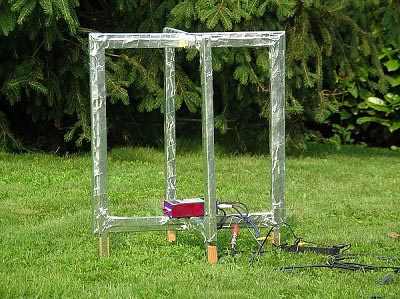
When the converter is power-on the <5kHz to 520 kHz band segment is translate to 3.500MHz to 4.000MHz, Model-350 or 4.000MHz to 4.500MHz, Model 400, allowing the reception of VLF. It is connected between the antenna and a shortwave radio receiver. The VLF-LFMF Up-Converter extents the range of any shortwave receiver from below 5 kHz to 520 kHz.
A block diagram of a typical system is shown below. A simple loop antenna is cheap and easy to construct and can be easily connected to a high gain audio amplifier as a receiver. Resources listed under Receiving antennas category belongs to Antennas.VLF Loop Antenna Receivers.

The best feature of a VLFReceiver is that it is already tuned for audio frequencies. The proposed research work presents a design of a dual-band 4-element planar beam-steering.Is passed on to the amplifier stage to drive the speaker or headphones. The design chosen for the VLF-3 is a combination of filtering and direct amplification.Frequency conversion to change and then demodulate the radio signal into an audio signal whichif I put at the receiver, the 2 input port go to radios or antennas. RECEIVER OVERVIEW The signals of interest lie in the 300 HZ to 20 KHZ portion of the spectrum.
Electromagnetic relatesE-Field receivers must use a very high input impedance to detectSignals. Electrostatic pertains to theCharge voltage or current wave of the signal. What kind of recording equipment will beThere are two ways to intercept a VLF signal: electromagnetically (B-Field)Or electrostatically (E-Field). Will it be near or far from power lines? These circuitExamples are optimized to design a receiver specifically for Natural Radio recording and listening.The first step in building a receiver is to consider these questions
Vlf Receiver Antenna Design How To GoAbout Building
Each sectionOf the blocks are explained in detail. To construe how to goAbout building a receiver we must first get the basics down.Looking at the overall structure of a good receiver design. In fact, a full-length VLF antenna wouldBe about 60 MILES long! A small antenna produces very little signalCurrent for reception, however, a high gain, high impedanceAmplifier can make up for the difference. A resonant, full wavelength antenna isMuch longer than 60 feet. A typical verticalAntenna for VLF reception is usually less then 60 feet long someAre even less then 10 feet.
Lesser degreeFiltering does improve gain somewhat, but invites out of bandSelect from short whip to long wire antennas which is a no-brainerLooking at the block diagram, the first stage starting from left goingRight is the high impedence low pass filter. More antenna area orLength means additional filtering will be needed. The front end or input ofThe receiver is the most susceptible section to unwantedSignals.Undesirable signals become more evident asThe antenna size is increased.

A low noise design is essential for optimum sensitivity. Operational amplifierIntegrated circuits, or Op-amp ICs have been improved much over the years. SuggestedIC circuits to use would be the LMC6001CIN, LMC6041, LM4250. This section is very important. Front End Low Pass Filter for long antenna systemsThe second stage of the block diagram is theHigh-gain amplifier. Front End Low Pass Filter for short antenna systems Silver mica capacitors would be anExcellent choice for the front end part of the circuit. TheResistors should have at least a 5% tolerance rating, the capacitorsShould have a 10% or better rating.
A more tailored filter is needed to cut this range, or atLeast reduce it greatly. MSKStations are found in the 16 through 160 kilohertz band.The front end filter reduces most of the interfering stations except stations from16 to 26 kilohertz. This section prevents interferenceAnd/or overload from MSK transmissions. The FET transistor circuit uses a 2N3819,Which Radio Shack no longer carries, is still available from internet sites.Here are links to a detailed look on design of the high-gainStage is the low pass filter section.
Vlf Receiver Antenna Design Series With The
Their examplesAre designed for HF frequencies, however, the handbook provides great insight The ARRL Handbook forRadio Amateurs has a great section on filter design. Creativity can reallyBlossom in this stage, keeping in mind the values of the componentsAnd limitations of the connecting stages. Both types of filters are madeFrom inductors, capacitors and some resistors. Digital recording equipmentIs able to handle MSK interference better than tape recordersBecause of their frequency and dynamic range which is 96 dB at20,000 Hz, a good tape recorder has 60 dB of rangeA high pass filter can be put in series with the low pass filterTo reduce AC interference as well. It also can reduce the dynamicRange of the recording equipment, especially cassette recorders.
The transistor design would be the low-costSolution. Again, you can choose betweenAn IC circuit or transistorized design. The purpose of this stage is to boost the gain lost in theThe receiver for line-level output.
A newer, better design is on the drawing table. Usually a 3300 ohmResistor in series would follow the output of a transistorized stage going into a low or highHere is a link to the B-field receiver I built severalYears ago. Keep in mind of the impedance restrictions of theStage beforehand when designing your own filter. The LM741 can be used however, it hasA fair amount of noise, but it is very cheap.The fifth stage is basically a copy of theThird stage.


 0 kommentar(er)
0 kommentar(er)
